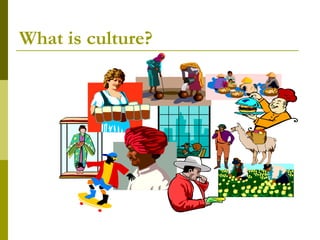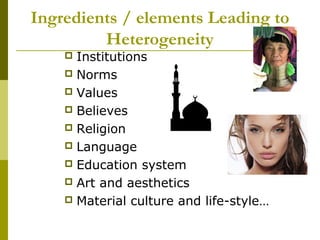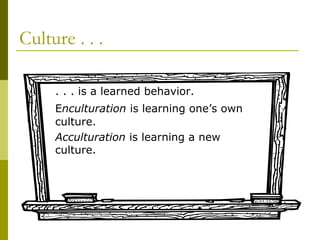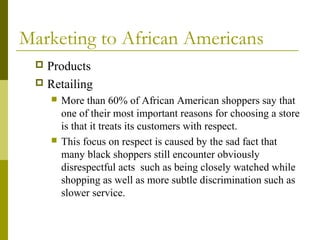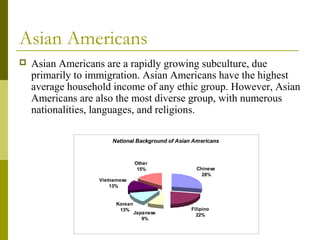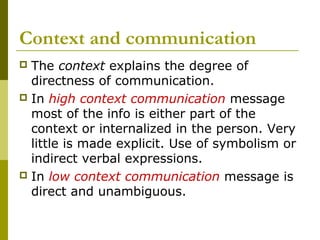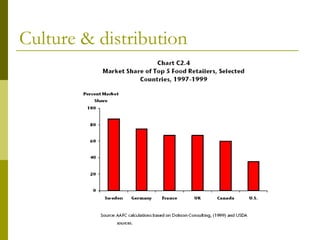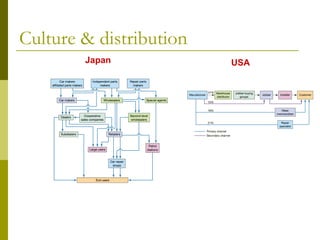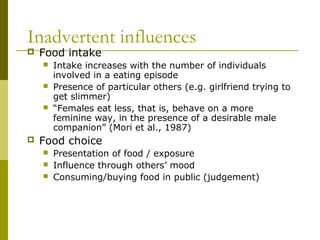Culture and Consumer Behavior
- 1. Culture and Consumer Behaviour
- 2. Contents Culture Sub Culture Cross Culture Culture and Consumer Behaviour Measurement of Culture
- 4. Culture is contextually based! The common grasshopper USA: Pest! CHINA: House pet! Thailand: A snack! Culture is an important part of international business and marketing!!!
- 5. Culture: Is the accumulation of shared meanings, rituals, norms, and traditions among the members of an organization or society.
- 6. Culture is… “ Collective programming of the mind which distinguishes the members of one human group from another... Includes system of values; and values are among the building blocks of culture...” (Hofstede, 1980) Glue that binds groups together. Without cultural patterns, organized system of significant symbols, people would have difficulty living together (De Mooij, 2004) Set of control mechanisms – plans, recipes, rules, instructions – for governing behavior (Geertz, 1973) Includes shared believs, attitudes, norms, roles and values found among speakers of a particular language who live during the same period in a specific geographic region (Triandis, 1995).
- 7. There is difference in terms of individualism/collectivism
- 8. Characteristics of culture 1. Culture is learned 2. Common to members of a certain group 3. Determines the behavior of group members 4. Culture (customs, values, habits) makes life more effective AN INDIVIDUAL DOESN’T HAVE CULTURE! AN INDIVIDUAL HAS A PERSONALITY!
- 9. Characteristics of Culture: By Keith Williams Culture exists to serve the needs of the society Culture is acquired from society throughout our life time. Culture is not static Culture is learned through interactions with other members of the culture. Culture is transferred from generations to generations. Culture will be adaptive to the needs of the society.
- 10. Culture and CB Culture has immense influence on the values and lifestyles of individuals. it cannot be underestimated as it actually affects their thoughts, motives and value systems Due to this dynamism people’s psychological construct changes and, therefore, their consumption patterns
- 11. Culture and CB…… culture explicates the value systems of the consumers that subsequently governs the interpretation of environment around the consumers. it plays an immense role in affecting the consumers’ affective and cognitive choices of consumption and spending.
- 12. Culture and CB……. Core values of a society define the usage of products Positive and negative valences for brands and for communication programs Culture define the ideology of consumption
- 13. Causes : Dissolving boundaries across national culture Multinationalization, globalisation World tourism, World sports World communication (media) Global education Global workforce Global supply chain Global virtual teams Global organization Transnational cosmopolitanism
- 14. Transnational Company A global network of productive units with a decentralized authority structure and no distinct national identity Relies on a blend of global and local strategies
- 15. Such scenario can lead to global consumption homogenization.
- 16. ©2000 Prentice Hall WorldWorld BrandsBrands Products that are manufactured, packaged, and positioned the same way regardless of the country in which they are sold.
- 17. ©2000 Prentice Hall • However, the counterargument is that local culture remains influential on CB. Leading the consumption pattern heterogeneous.
- 18. Ingredients / elements Leading to Heterogeneity Institutions Norms Values Believes Religion Language Education system Art and aesthetics Material culture and life-style…
- 19. Copyright © Houghton Mifflin Company. All rights reserved. Chapter Four | 19
- 20. ©2000 Prentice Hall Observations on the Differences Between Japan and American Cultural Traits JAPANESE CULTURE, TRAITS AMERICAN CULTURE, TRAITS •Japanese language •English language •Homogeneous •Diverse •Harmony to be valued and preserved •Fight for one’s belief’s/positions •Ambiguous •Clearcut •General •Specific •Unspoken agreement •Get the facts straight •Holdback emotions in public •Display emotions in public
- 21. ©2000 Prentice Hall continued JAPANESE CULTURE, TRAITS AMERICAN CULTURE, TRAITS •Process-oriented •Result-oriented •Fun-oriented •Humor-oriented •Make a long story short •Make a short story long •Nonverbal communication important •Verbal communication important •Interested in who is speaking •Interested in what is spoken
- 22. Culture . . . . . . is a learned behavior. Enculturation is learning one’s own culture. Acculturation is learning a new culture.
- 23. SubcultureSubculture A distinct cultural group that exists as an identifiable segment within a larger, more complex society. 23Copyright 2010 Pearson Education, Inc. Publishing as Prentice Hall Chapter Twelve Slide
- 24. Subculture A subculture is a segment of a larger culture whose members share distinguishing values and patterns of behavior. The unique values and patterns of behavior shared by subculture group members are based on the social history of the group as well as on its current situation.
- 25. single community with dual ethnic groups
- 26. Marketing to African Americans Products Retailing More than 60% of African American shoppers say that one of their most important reasons for choosing a store is that it treats its customers with respect. This focus on respect is caused by the sad fact that many black shoppers still encounter obviously disrespectful acts such as being closely watched while shopping as well as more subtle discrimination such as slower service.
- 27. Asian Americans Asian Americans are a rapidly growing subculture, due primarily to immigration. Asian Americans have the highest average household income of any ethic group. However, Asian Americans are also the most diverse group, with numerous nationalities, languages, and religions. National Background of Asian Americans Chinese 28% Filipino 22%Japanese 9% Korean 13% Vietnamese 13% Other 15%
- 28. Native Americans Nearly half live in the West, and there are approximately 550 Native American tribes, each with its own language and traditions. Asian-Indian Americans There are approximately 1.7 million Americans of Indian heritage. There are well educated, affluent, and fluent in English. Arab Americans They are approximately 1 million Arab Americans in the U.S.. They are come from a variety of countries, including Morocco, Egypt, Jordan, and Kuwait. They share a common Arabic heritage and the Arabic language.
- 30. Issues in Understanding Gender as a Subculture • Sex Roles and Consumer Behavior – Masculine vs. Feminine Traits • Consumer Products and Sex Roles • Women as depicted in Media 30Copyright 2010 Pearson Education, Inc. Publishing as Prentice Hall Chapter Twelve Slide
- 31. SubculturalSubcultural InteractionInteraction Marketers should strive to understand how multiple subcultural memberships jointly influence consumers behavior Chapter Twelve Slide
- 32. Cross Culture
- 33. The imperative to be multinational Acquiring exposure to other cultures Through consumers’ own initiatives Through movies, theatre and art Through new products/services Culture transfer through international marketing Country of origin effects Consumers use their knowledge of where products are made in the evaluation of their purchase options Common associations France – perfumes, wine, clothing Italy – shoes, sports cars, furniture Japan – cameras and consumer electronics Germany – cars, tools and machinery India – spices, textiles, jewellery US – computers, entertainment, fast-food
- 34. ©2000 Prentice Hall Basic Research Issues in Cross-Cultural Analysis FACTORS Differences in language and meaning Difference in market segmentation opportunities Difference in consumption patterns Difference in the perceived benefits of products and services EXAMPLES Words or concepts may not mean the same in two different countries. The income, social class, age, and sex of target customers may differ dramatically in two different countries. Two countries may differ substantially in the level of consumption or use of products or services. Two nations may use or consume the same product in very different ways.
- 35. ©2000 Prentice Hall continued FACTORS Differences in the criteria for evaluating products and services Differences in economic and social conditions and family structure Differences in marketing research and conditions Differences in marketing research possibilities EXAMPLES The benefits sought from a service may differ from country to country. The “style” of family decision making may vary significantly from country to country. The types and quality of retail outlets and direct-mail lists may vary greatly among countries. The availability of professional consumer researchers may vary considerably from country to country.
- 36. ©2000 Prentice Hall A Framework for Alternative Global Marketing Strategies PRODUCT STRATEGY COMMUNICATON STRATEGY STANDARDIZED COMMUNICATIONS LOCALIZED COMMUNICATIONS STANDARDIZED PRODUCT Global strategy: Uniform Product/ Uniform Message Mixed Strategy: Uniform Product/ Customized Message LOCALIZED PRODUCT Mixed strategy: Customized Product/ Uniform Message Local Strategy: Customized Product/ Customized Message
- 37. Culture and the marketing mix
- 38. Context and communication The context explains the degree of directness of communication. In high context communication message most of the info is either part of the context or internalized in the person. Very little is made explicit. Use of symbolism or indirect verbal expressions. In low context communication message is direct and unambiguous.
- 40. Culture & pricing decisions Source: Hollensen, S. (2008). Global marketing. Pearson Education.
- 42. Culture & distribution Japan USA
- 43. The Measurement of Culture • Content Analysis: systematically analyzing the content of verbal and/or pictorial communication. Is frequently used to determine prevailing social values of a society. • Consumer Fieldwork: Field Observation (natural setting, subject unaware, focus on observation of behavior); Participant Observation • Value Measurement Instruments: Rokeach Value Survey (RVS); List of Values (LOV); VALS 43
- 44. Value Measurement Survey Instruments Chapter Eleven Slide
- 45. You are what you eat
- 46. Indirect socio-cultural effects Food intake Imports Appropriate portion size / packaging Price Convenience Food choice Availability Cultural interest in a food Cultural avoidance of a food
- 47. Indirect personal effects Food intake Body image/ideals and eating Norms about meal size and timing Food choice Social and moral implication of eating Food-health links Preferences versus likes Food presentation (cuisine)
- 48. Direct sociocultural influences Inadvertent No intent on the part of the social agent Advertent Intentional role to influence food intake or choice
- 49. Inadvertent influences Food intake Intake increases with the number of individuals involved in a eating episode Presence of particular others (e.g. girlfriend trying to get slimmer) “Females eat less, that is, behave on a more feminine way, in the presence of a desirable male companion” (Mori et al., 1987) Food choice Presentation of food / exposure Influence through others’ mood Consuming/buying food in public (judgement)
- 50. Advertent influences Media information Social (e.g. parental) influence Flattering Persuading Threatening Bribing
Editor's Notes
- A subculture has beliefs, values, and customers that set them apart from the other members of the same society.
- You have probably heard these terms before. Marketers and other researchers divide the population into groups depending on the year they were born. There are many differences between these age subcultures, which will be explored in the following slides.
- Gender plays an important role in some marketing issues. Men and women react differently toward print ads and have very different shopping motives. As such, some consumer products are much more focused to one sex versus the other. It is only in the past few years that men have increased their purchases of consumer care products, including moisturizers and hair care products. Many women are concerned with the way they are depicted in media and would like to see more of the “real” women that advertisers like Dove have begun to use. Follow this web link to the Campaign for Real Beauty by Dove to learn more about the campaign.
- It is important for marketers to realize that an individual can belong to several of the subcultures presented in these slides and must consider how these influences will work together.
- Measurement techniques are used to track values and social trends for government and business. Each one will be looked at individually on the following slides.
- Instead of observing behavior, these techniques use surveys of consumers. As you can see, there are a variety of these studies, each a bit different in the number of questions that are asked and the categories they choose to emphasize.


